- 机器学习在安全领域的应用:从大数据中识别潜在安全威胁
- Rust使用calamine读取excel文件,Rust使用rust
- 深入理解 SQL UNION 运算符及其应用场景
- uniapp里面tabbar自定义的方法
- MySQL中的CASE WHEN语句:用法、示例与解析
- Jenkins简介及安装配置详解:开启持续集成之旅
- Django中的实时通信:WebSockets与异步视图的结合
- 输了,腾讯golang一面凉了
- uniapp+springboot 实现前后端分离的个人备忘录系统【超
- Mac 版 IDEA 中配置 GitLab
- Linux部署Sonarqube+Gogs+Jenkins(一)
- PTA L1-064 估值一亿的AI核心代码,详解+每一个测试点的分析
- 【粉丝福利社】 Node.js从入门到精通(软件开发视频大讲堂)(文末
- MyBatisPlus(SpringBoot版)的分页插件
- IDEA 2024 配置 Maven 创建 Spring Boot 项
- Mysql SQL优化
- MySQL篇—启动或者关闭linux下MySQL数据库的多种方式
- 【微服务】spring状态机模式使用详解
- SpringBoot集成WebSocket,实现后台向前端推送信息
- slurm深度解析:探索作业调度系统的架构和术语
- 若依(前后端分离版)部署全流程 | 宝塔部署SpringBoot项目踩
- 主流Golang框架对比以及介绍
- Jenkins 命令无法后台运行,使用BUILD
- 大话设计模式——22.访问者模式(Visitor Pattern)
- JavaWeb项目:航班信息管理系统(tomcat+jsp)
- 前端vue uni-app仿美团下拉框下拉筛选组件
- 使用Node.js搭建服务器
- 【k8s】:部署、使用 metrics-server
- 深入OceanBase内部机制:多租户架构下的资源隔离实现精讲
- 【Go设置国内代理】
💗推荐阅读文章💗
- 🌸JavaSE系列🌸👉1️⃣《JavaSE系列教程》
- 🌺MySQL系列🌺👉2️⃣《MySQL系列教程》
- 🍀JavaWeb系列🍀👉3️⃣《JavaWeb系列教程》
- 🌻SSM框架系列🌻👉4️⃣《SSM框架系列教程》
🎉本博客知识点收录于🎉👉🚀《MySQL系列教程》🚀—>✈️03【锁、事务原理、MVCC】✈️
文章目录
- 2.4 临键锁
- 2.4.1 临键锁的区间测试
- 2.4.2 临键锁-普通列
- 1)间隙锁
- 2)记录锁
- 2.4.3 临键锁-普通索引
- 1)非临界值
- 2)临界值
- 3)范围值
- 2.4.4 临键锁-主键和唯一索引
- 1)非临界值
- 2)临界值
- 3)范围值
- 2.4.5 临键锁总结
2.4 临键锁
2.4.1 临键锁的区间测试
临键锁(Next-Key Lock):临键锁是查询时InnoDB根据查询的条件而锁定的一个范围,这个范围中包含有间隙锁和记录数;临键锁=间隙锁+记录锁。
其设计的目的是为了解决Phantom Problem(幻读);主要是阻塞insert,但由于临键锁中包含有记录锁,因此临键锁所锁定的范围内如果包含有记录,那么也会给这些记录添加记录锁,从而造成阻塞除insert之外的操作;
Tips:临键锁的主要目的,也是为了避免幻读(Phantom Read)。如果把事务的隔离级别降级为RC,临键锁则也会失效。
临键锁锁住的区间为:记录+区间(左开右闭)
左开右闭:不锁住左边,锁右边
测试表:
drop table if exists t2; CREATE TABLE `t2` ( `id` int(11) NOT NULL AUTO_INCREMENT, `num` int(11) , PRIMARY KEY (`id`) USING BTREE ) ENGINE = InnoDB ; INSERT INTO `t2`(`id`, `num`) VALUES (5, 5); INSERT INTO `t2`(`id`, `num`) VALUES (10, 10); INSERT INTO `t2`(`id`, `num`) VALUES (15, 15); INSERT INTO `t2`(`id`, `num`) VALUES (20, 20); -- 创建普通索引 create index idx_num on t2(num); -- 创建唯一索引 create unique index idx_num on t2(num); -- 删除索引 drop index idx_num on t2;
- 区间示意图:

Tips:间隙锁只会阻塞insert,记录锁会阻塞任意的锁(单要注意排他锁和共享锁的关系);
【测试案例-01-间隙锁】
临键锁的触发不仅把条件区间(11-16)的数据行锁住了,还把临键的数据行统统锁住了;锁住的区间为:(10,15]、(15,20]
锁住的id范围:10(不含)~20(含)
session1 session2 begin; begin; select * from t2 where id>11 and id<16 for update; insert into t2 values(10,0); – 不阻塞 insert into t2 values(11,0); – 阻塞 insert into t2 values(15,0); – 阻塞 insert into t2 values(16,0); – 阻塞 insert into t2 values(18,10); – 阻塞 insert into t2 values(20,0); – 阻塞 insert into t2 values(21,0); – 不阻塞 rollback; rollback; 【案例测试-02-记录锁】
临键锁是间隙锁+记录数的;上述案例中测试了临键锁中的间隙锁,这次我们来测试一下临键锁中的记录锁;
session1 session2 begin; begin; select * from t2 where id>11 and id<16 for update; select * from t2 where id=12 for update; – 间隙锁,不阻塞 select * from t2 where id=15 for update; – 记录数,阻塞 select * from t2 where id=17 for update; – 间隙锁,不阻塞 select * from t2 where id=20 for update; – 记录数,阻塞 rollback; rollback; 2.4.2 临键锁-普通列
我们刚刚测试的是以主键索引进行测试,如果采用不同的列(普通列、普通索引、唯一索引/主键索引等),则临键锁中的间隙锁和记录锁住的内容大不相同;
如果查询的是普通列,那么触发的临键锁为:表级别的间隙锁+表级别的记录锁
- 测试表:
drop table if exists t2; CREATE TABLE `t2` ( `id` int(11) NOT NULL AUTO_INCREMENT, `num` int(11) , PRIMARY KEY (`id`) USING BTREE ) ENGINE = InnoDB ; INSERT INTO `t2`(`id`, `num`) VALUES (5, 5); INSERT INTO `t2`(`id`, `num`) VALUES (10, 10); INSERT INTO `t2`(`id`, `num`) VALUES (15, 15); INSERT INTO `t2`(`id`, `num`) VALUES (20, 20);
1)间隙锁
【案例测试-01-表级别间隙锁】
session1 session2 begin; begin; select * from t2 where num=11 for update; insert into t2 values(null,3); – 阻塞 insert into t2 values(null,5); – 阻塞 insert into t2 values(null,8); – 阻塞 insert into t2 values(null,10); – 阻塞 insert into t2 values(null,18); – 阻塞 insert into t2 values(null,21); – 阻塞 rollback; rollback; Tips:innoDB查询如果没有使用到索引默认触发表级临键锁,把所有的间隙都锁住了
2)记录锁
以普通列查询除了会触发表级别的临键锁外,同时还会触发表级别的记录锁;
【案例测试-02-表级别记录锁】
session1 session2 begin; begin; select * from t2 where num=11 for update; select * from t2 where id=3 for update; – 间隙锁,不阻塞 select * from t2 where id=5 for update; – 记录数,阻塞 select * from t2 where id=8 for update; – 间隙锁,不阻塞 select * from t2 where id=15 for update; – 记录数,阻塞 select * from t2 where id=18 for update; – 间隙锁,不阻塞 select * from t2 where id=20 for update; – 记录数,阻塞 rollback; rollback; 2.4.3 临键锁-普通索引
如果查询的列为普通索引列,要看被查询的记录是否在临界值,以及是否是范围查询,才能判断临建锁的范围;
- 被查询的记录是否在临界值情况:
- 非临界值:那么间隙锁为当前记录所在的区间,记录锁则不会生效(记录锁不存在);
- 临界值:那么间隙锁为相邻的两个区间,记录锁退化成行锁(即只会锁住被查询的那条记录);
- 范围查询情况:间隙锁为范围所涉及到的所有区间,记录锁也会升级为范围锁涉及到的区间
drop table if exists t2; CREATE TABLE `t2` ( `id` int(11) NOT NULL AUTO_INCREMENT, `num` int(11) , PRIMARY KEY (`id`) USING BTREE ) ENGINE = InnoDB ; INSERT INTO `t2`(`id`, `num`) VALUES (5, 5); INSERT INTO `t2`(`id`, `num`) VALUES (10, 10); INSERT INTO `t2`(`id`, `num`) VALUES (15, 15); INSERT INTO `t2`(`id`, `num`) VALUES (20, 20); -- 创建普通索引 create index idx_num on t2(num);
1)非临界值
当使用普通索引列查询,查询的记录不处于临界值时,那么间隙锁为被查询记录所在的区间,记录锁则不会生效;
【测试案例-01-间隙锁】
session1 session2 begin; begin; – 触发间隙锁,锁住(15,20]区间 select * from t2 where num=17 for update; insert into t2 values(null,15); – 阻塞 insert into t2 values(null,18); – 阻塞 insert into t2 values(null,20); – 不阻塞 rollback; rollback; num=17这条记录不是会锁定(15,20]区间吗?为什么15被阻塞了,20反而没被阻塞呢?
这里需要牵扯到另一个问题了,在InnoDB中,相同的普通索引的叶子节点是以主键的顺序进行排列的,我们来模拟一下刚刚插入的数据在B+Tree上的变化:
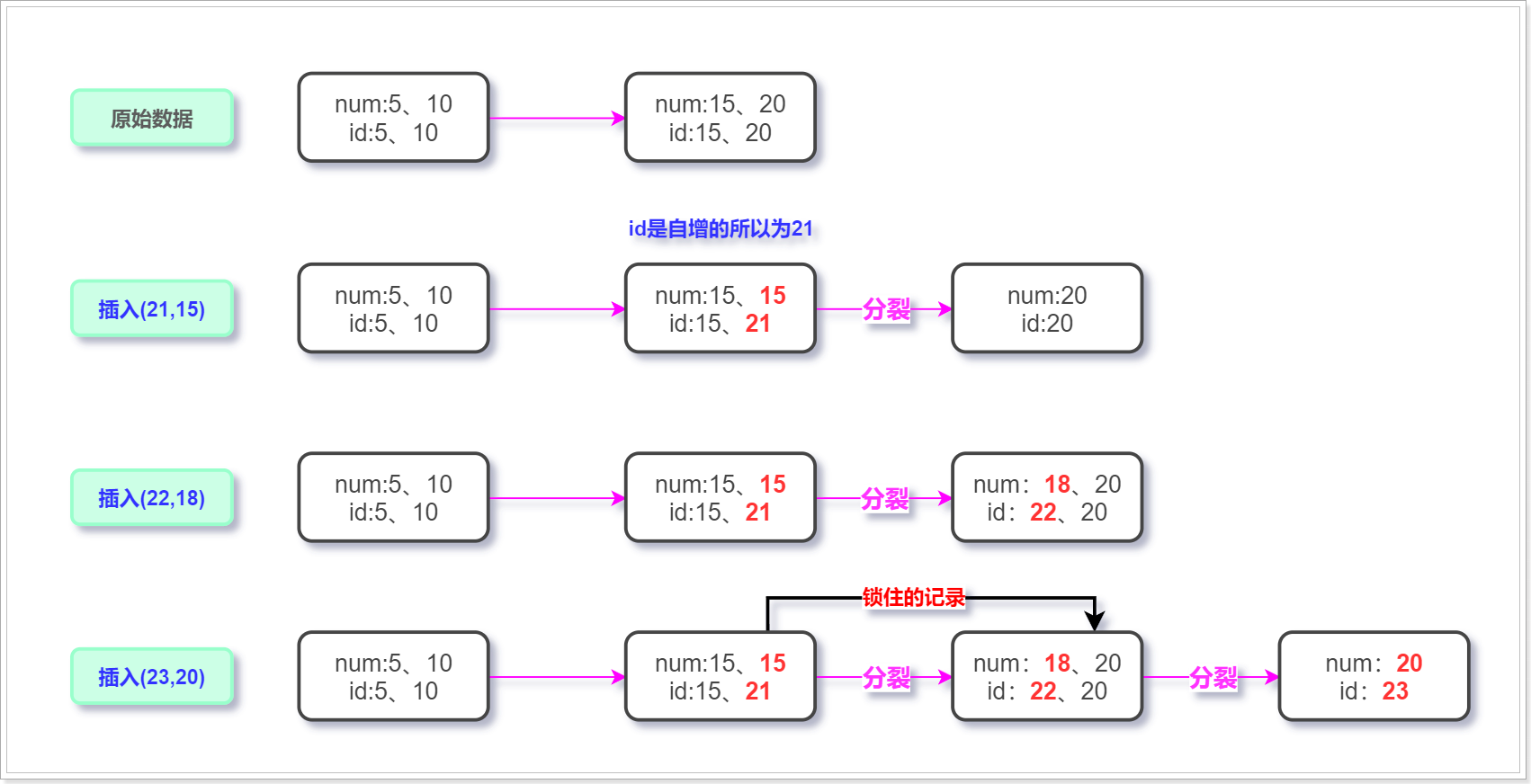
只考虑叶子节点的变化,可以看到在上图在演变的过程中产生了分裂情况(假设每个叶子节点都只存储两个元素),如果普通索引的重复值太多势必会造成大量的分裂情况,减低插入效率,因此索引列不宜选择重复率太大的列;
再看下图数据库表中实际存储的列的样子我们就会明白为什么num=20不阻塞,num=15阻塞了
- num索引列排列情况:
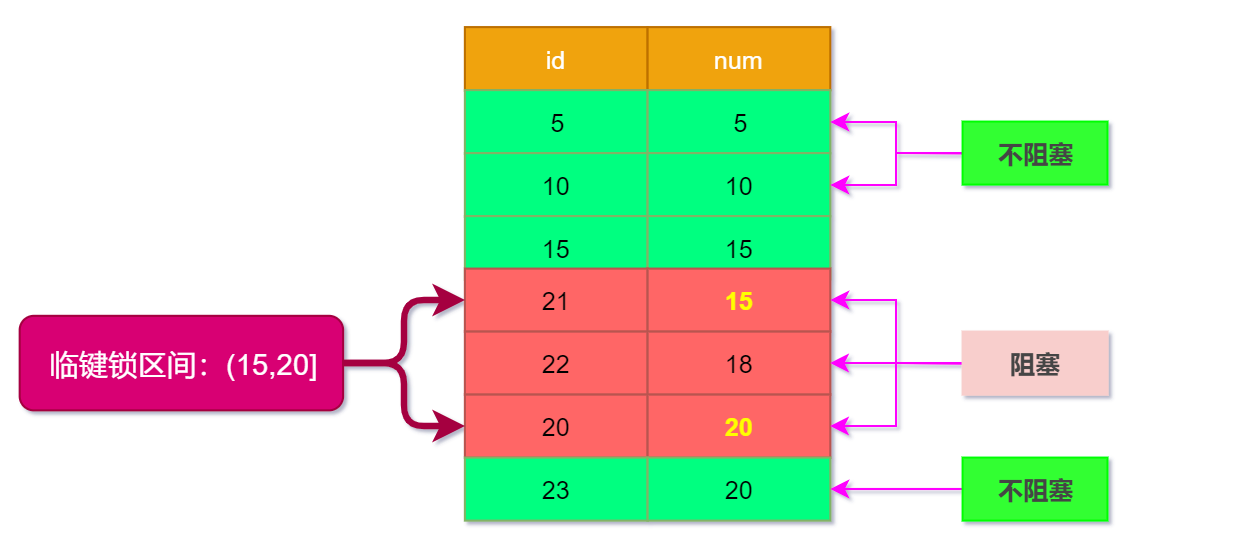
查询示意图:
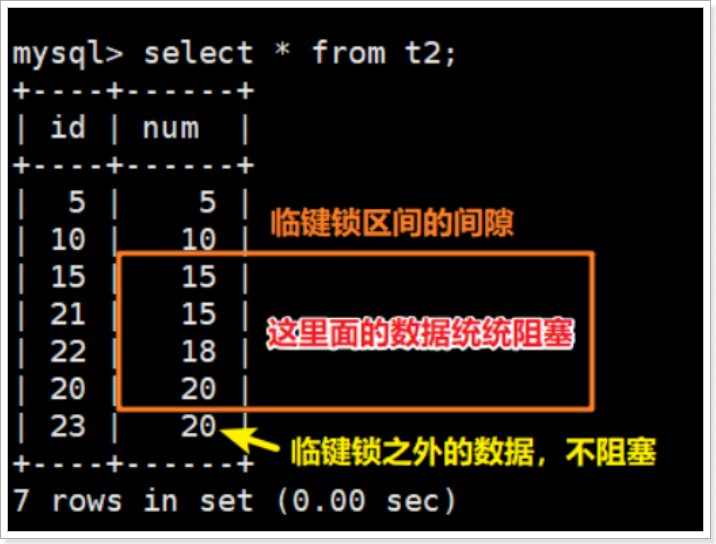
【测试案例-02-间隙锁】
当我们把id列的影响也计算进来时,数据就符合我们正常分析的情况了:
session1 session2 begin; begin; – 触发间隙锁,锁住(15,20]区间 select * from t2 where num=17 for update; insert into t2 values(14,15); – 不阻塞 insert into t2 values(18,18); – 阻塞 insert into t2 values(19,20); – 阻塞 rollback; rollback; 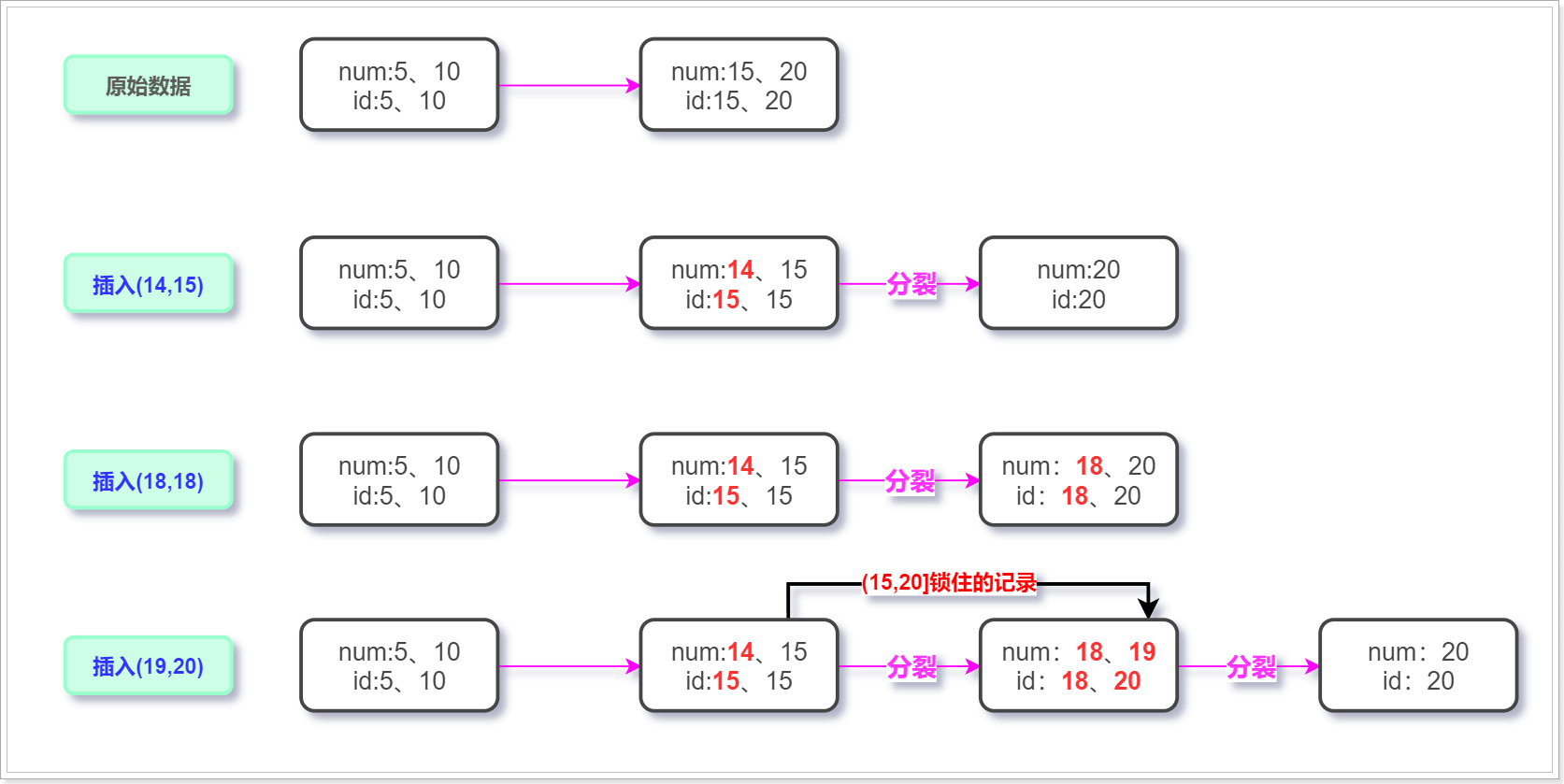
【测试案例-03-记录锁】
当使用普通索引列查询,查询的记录不处于临界值时,那么间隙锁为被查询记录所在的区间,记录锁则不会生效
session1 session2 begin; begin; – 没有num=17的这条记录,记录锁不会存在 select * from t2 where num=17 for update; select * from t2 where num=15 for update; – 不阻塞 select * from t2 where num=16 for update; – 不阻塞 select * from t2 where num=17 for update; – 不阻塞 select * from t2 where num=20 for update; – 不阻塞 rollback; rollback; 2)临界值
【测试案例-01-间隙锁】
当使用普通索引列来查询,并且查询的记录处于临界值时,那么间隙锁为相邻的两个区间,记录锁退化成行锁;
下面案例将会锁住(10,15]、(15,20]两个区间
session1 session2 begin; begin; – 触发的间隙锁的区间为(10,15]、(15,20] select * from t2 where num=15 for update; insert into t2 values(null,8); – 不阻塞 insert into t2 values(null,10); – 阻塞 insert into t2 values(null,11); – 阻塞 insert into t2 values(null,15); – 阻塞 insert into t2 values(null,18); – 阻塞 insert into t2 values(null,20); – 不阻塞 rollback; rollback; 发现实际插入的数据跟我们分析的情况不一致,这个时候我们依然也要观察B+Tree的实现:
- 索引底层构建过程:
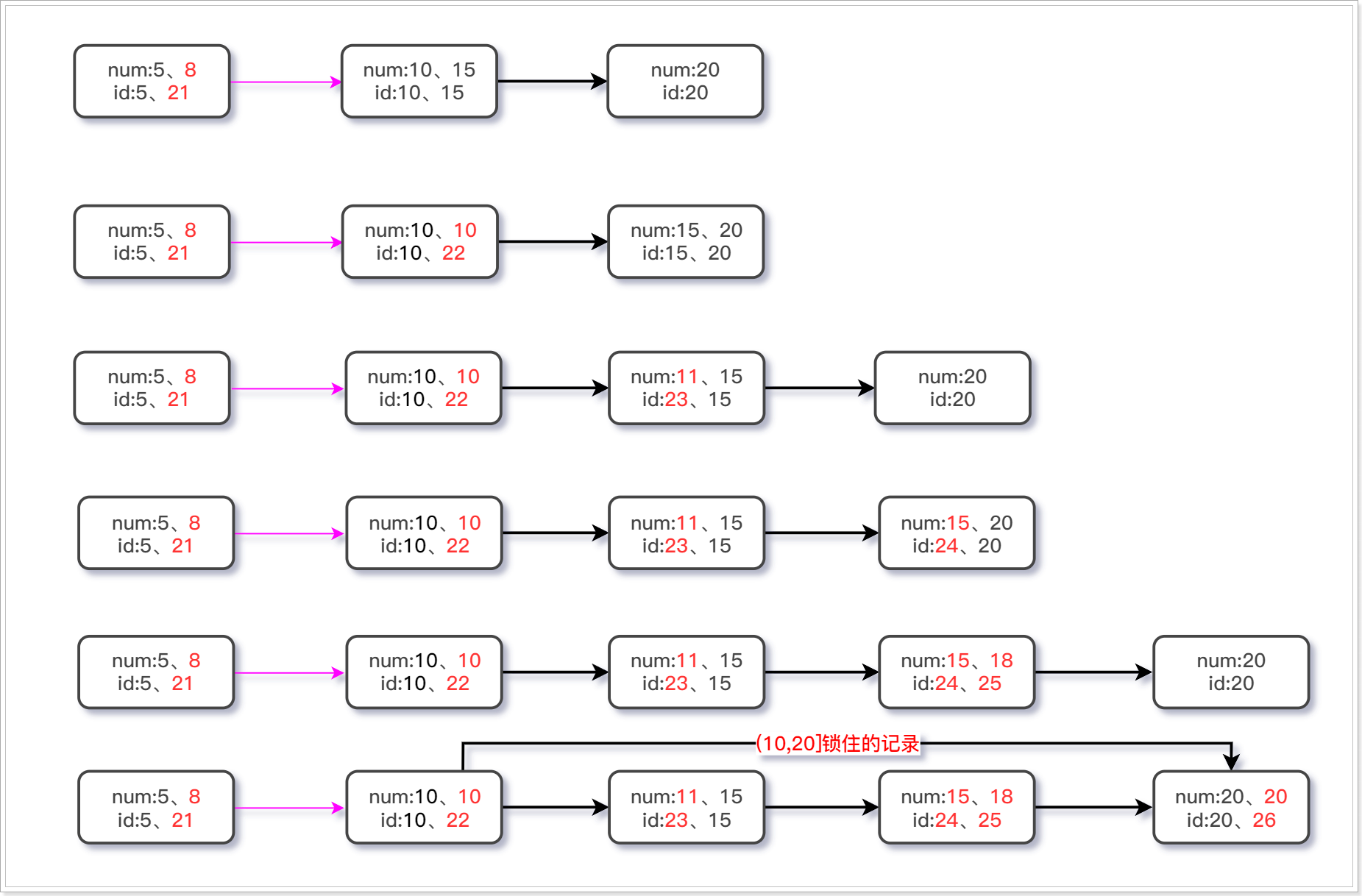
- 临键锁区间:
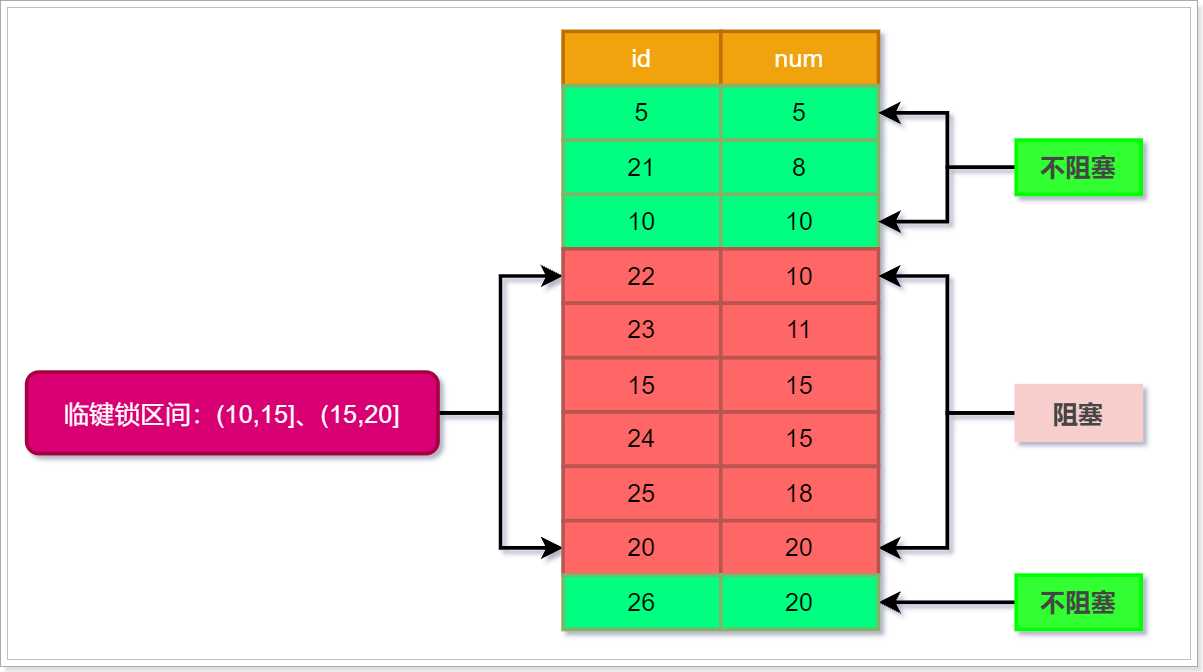
15处于(10,15]和(15,20]两个临键区间,因此在两个区间内的数据行都被锁住了
【测试案例-02-记录锁】
当使用普通索引列来查询,并且查询的记录处于临界值时,那么间隙锁为相邻的两个区间,记录锁退化成行锁;
session1 session2 begin; begin; – 记录锁只锁住num=15这行记录 select * from t2 where num=15 for update; select * from t2 where num=10 for update; – 不阻塞 select * from t2 where num=12 for update; – 不阻塞 select * from t2 where num=15 for update; – 阻塞 select * from t2 where num=18 for update; – 不阻塞 select * from t2 where num=20 for update; – 不阻塞 select * from t2 where num=22 for update; – 不阻塞 rollback; rollback; 3)范围值
【测试案例-01-间隙锁】
当使用普通索引进行条件范围查询时,那么间隙锁查询范围所涉及到的区间,记录锁也会升级为查询范围涉及到的区间;
session1 session2 begin; begin; – 间隙锁为(10,20]区间 select * from t2 where num>11 and num <16 for update; insert into t2 values(9,10); – 不阻塞 insert into t2 values(11,10); – 阻塞(参考B+Tree的构建) insert into t2 values(11,11); – 阻塞 insert into t2 values(12,12); – 阻塞 insert into t2 values(15,15); – 阻塞(被记录锁阻塞) insert into t2 values(18,18); – 阻塞 insert into t2 values(19,20); – 阻塞 insert into t2 values(21,20); – 不阻塞(参考B+Tree的构建) rollback; rollback; - 分析底层B+Tree构建情况:
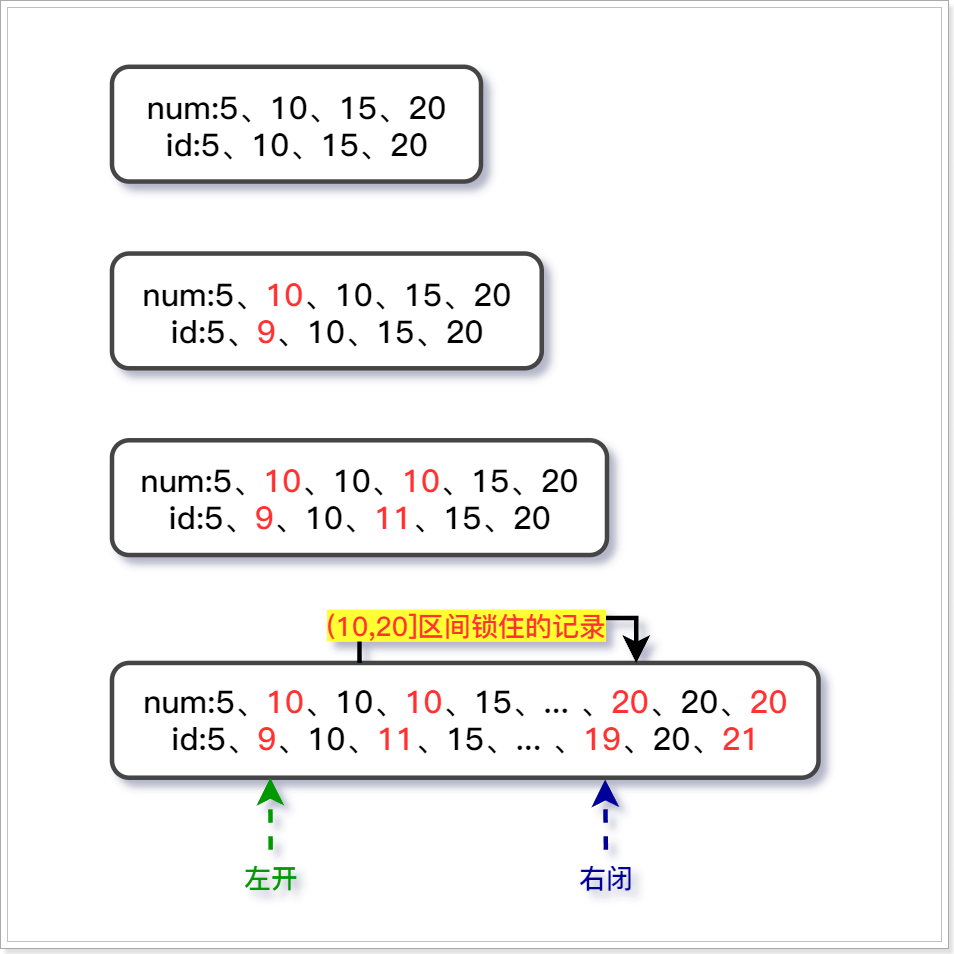
【测试案例-02-记录锁】
当使用普通索引进行条件范围查询时,那么间隙锁查询范围所涉及到的区间,记录锁也会升级为查询范围涉及到的区间;
session1 session2 begin; begin; – 记录锁的区间为(10,20]区间 select * from t2 where num>11 and num <16 for update; select * from t2 where num=10 for update; – 不阻塞(左开右闭) select * from t2 where num=12 for update; – 不阻塞(属于间隙) select * from t2 where num=15 for update; – 阻塞(触发记录锁) select * from t2 where num=16 for update; – 不阻塞(属于间隙) select * from t2 where num=18 for update; – 不阻塞(属于间隙) select * from t2 where num=20 for update; – 阻塞(左开右闭,触发记录锁) select * from t2 where num=21 for update; – 不阻塞(即是间隙,也不在区间) rollback; rollback; 2.4.4 临键锁-主键和唯一索引
如果查询的是唯一索引或主键索引,也要看被查询的记录是否在临界值;是否是范围查询等
- 被查询的记录是否在临界值情况:
- 不在临界值:间隙锁为当前被查询的记录所在的区间,记录锁会消失;
- 在临界值:间隙锁会消失,记录锁退化成行锁
- 范围查询情况:间隙锁为范围查询所涉及到的所有区间,记录数也会升级为范围所涉及到的区间(和普通索引的效果一致);
创建唯一索引:
-- 删除索引 drop index idx_num on t2; -- 创建唯一索引 create unique index idx_num on t2(num);
1)非临界值
唯一索引在查询非临界值的记录时和普通索引的特点一样,即==间隙锁为当前记录所在的区间,记录锁不生效;==
【测试案例-01-间隙锁】
session-01 session-02 begin; begin; – 间隙锁锁住的区间为(15,20] select * from t2 where num=17 for update; insert into t2 values(null,11); – 不阻塞 insert into t2 values(null,15); – 不阻塞 insert into t2 values(null,16); – 阻塞 insert into t2 values(null,18); – 阻塞 insert into t2 values(null,20); – 不阻塞 insert into t2 values(null,21); – 不阻塞 - 分析num列索引的B+Tree底层构建情况:
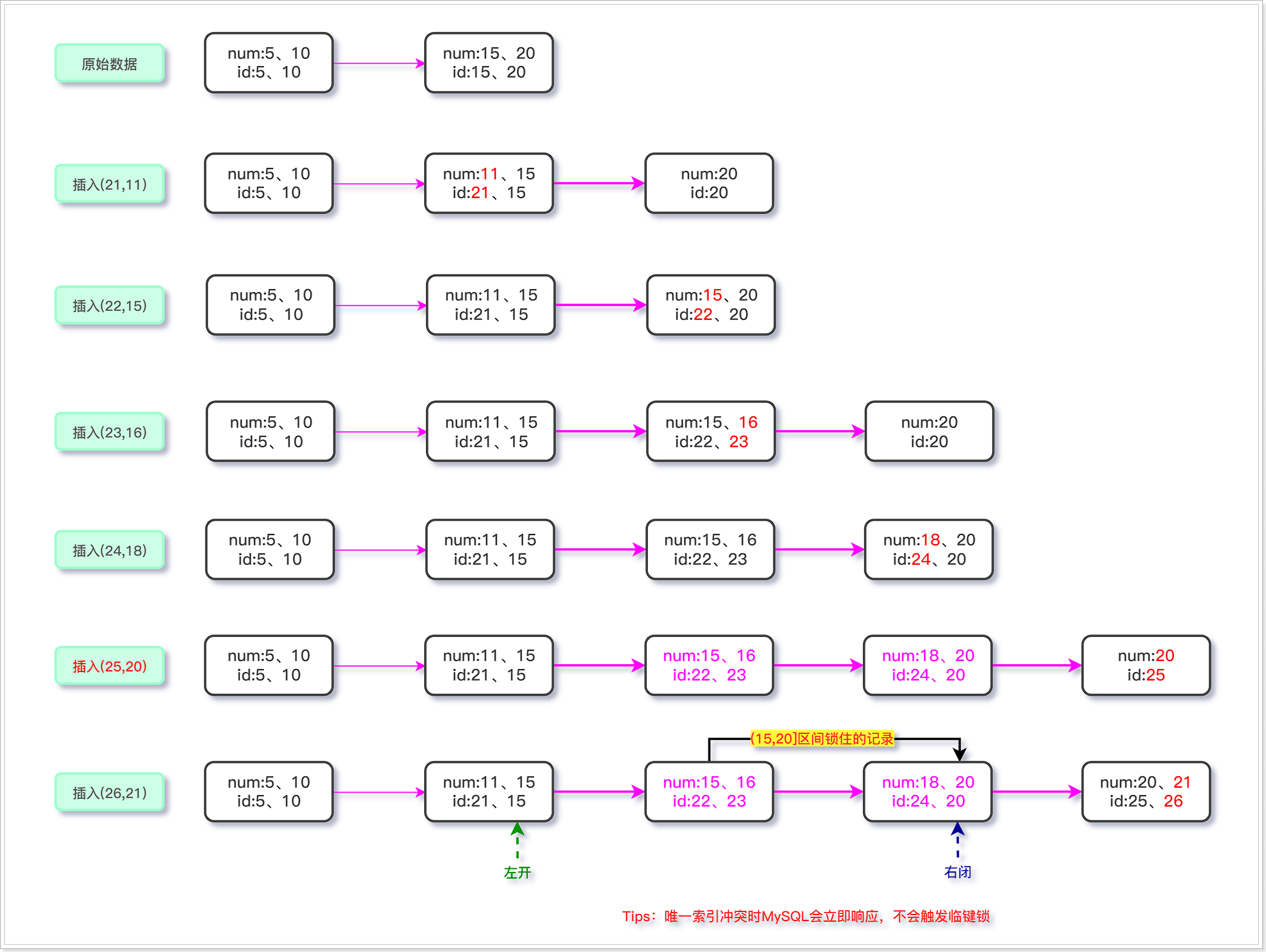
Tips:唯一索引冲突时MySQL会立即响应,不会触发临键锁
【测试案例-02-记录锁】
唯一索引在查询非临界值的记录时,记录锁不生效;
session1 session2 begin; begin; – 没有num=17的这条记录,记录锁不会存在 select * from t2 where num=17 for update; select * from t2 where num=15 for update; – 不阻塞 select * from t2 where num=16 for update; – 不阻塞 select * from t2 where num=17 for update; – 不阻塞 select * from t2 where num=20 for update; – 不阻塞 rollback; rollback; 2)临界值
在使用唯一索引查询临界值时,间隙锁会消失,记录锁会退化成行锁;
【测试案例-01-间隙锁】
session1 session2 begin; begin; select * from t2 where num=15 for update; insert into t2 values(null,4); – 不阻塞 insert into t2 values(null,8); – 不阻塞 insert into t2 values(null,11); – 不阻塞 insert into t2 values(null,15); – 阻塞(阻塞的原因是记录锁,而不是间隙锁) insert into t2 values(null,28); – 不阻塞 rollback; insert into t2 values(null,20); – 不阻塞 rollback; 【测试案例-02-记录锁】
session1 session2 begin; begin; – 记录锁只锁住num=15这行记录 select * from t2 where num=15 for update; select * from t2 where num=10 for update; – 不阻塞 select * from t2 where num=12 for update; – 不阻塞 select * from t2 where num=15 for update; – 阻塞 select * from t2 where num=18 for update; – 不阻塞 select * from t2 where num=20 for update; – 不阻塞 select * from t2 where num=22 for update; – 不阻塞 rollback; rollback; 3)范围值
【测试案例-01-间隙锁】
当使用普通索引进行条件范围查询时,那么间隙锁查询范围所涉及到的区间,记录锁也会升级为查询范围涉及到的区间;
session1 session2 begin; begin; – 间隙锁为(10,20]区间 select * from t2 where num>11 and num <16 for update; insert into t2 values(9,10); – 不阻塞 insert into t2 values(11,10); – 阻塞(参考B+Tree的构建) insert into t2 values(11,11); – 阻塞 insert into t2 values(12,12); – 阻塞 insert into t2 values(15,15); – 阻塞(被记录锁阻塞) insert into t2 values(18,18); – 阻塞 insert into t2 values(19,20); – 阻塞 insert into t2 values(21,20); – 不阻塞(参考B+Tree的构建) rollback; rollback; - 分析底层B+Tree构建情况:
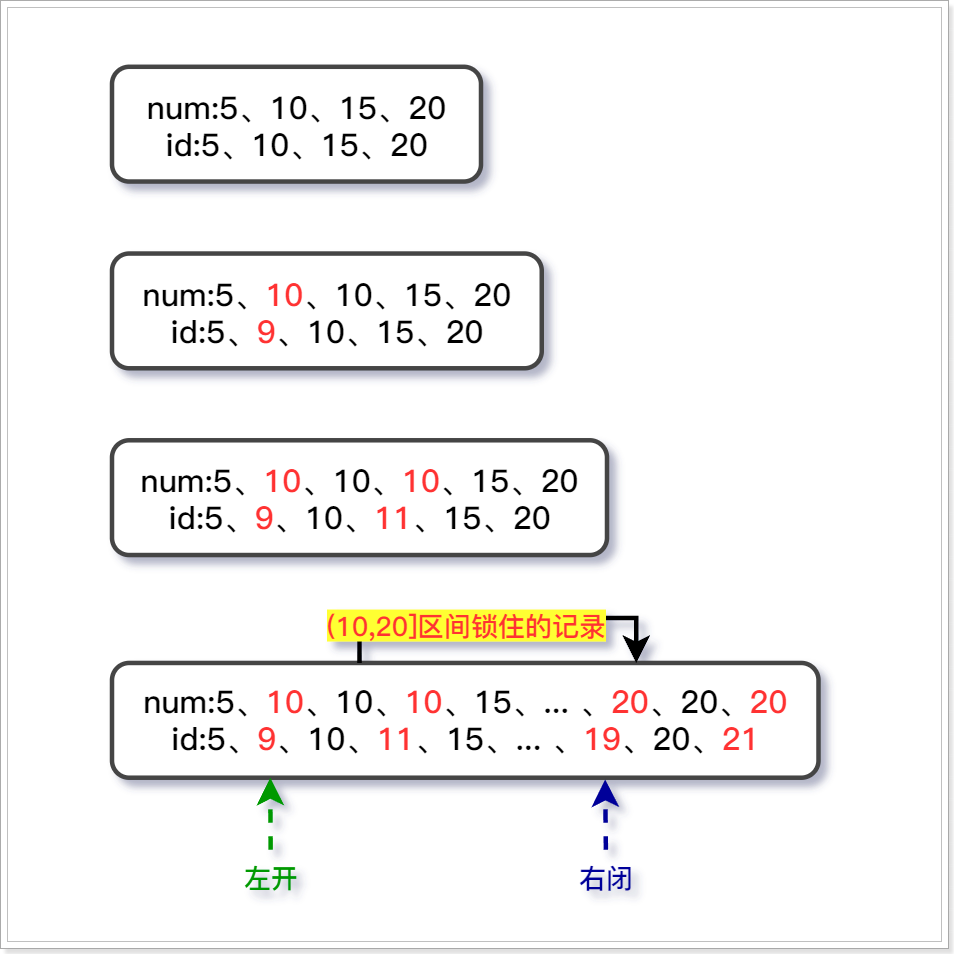
【测试案例-02-记录锁】
当使用普通索引进行条件范围查询时,那么间隙锁查询范围所涉及到的区间,记录锁也会升级为查询范围涉及到的区间;
session1 session2 begin; begin; – 记录锁的区间为(10,20]区间 select * from t2 where num>11 and num <16 for update; select * from t2 where num=10 for update; – 不阻塞(左开右闭) select * from t2 where num=12 for update; – 不阻塞(属于间隙) select * from t2 where num=15 for update; – 阻塞(触发记录锁) select * from t2 where num=16 for update; – 不阻塞(属于间隙) select * from t2 where num=18 for update; – 不阻塞(属于间隙) select * from t2 where num=20 for update; – 阻塞(左开右闭,触发记录锁) select * from t2 where num=21 for update; – 不阻塞(即是间隙,也不在区间) rollback; rollback; 2.4.5 临键锁总结
临键锁是InnoDB在查询数据时锁定的一个范围,这个范围包含有间隙锁和记录锁;根据查询的条件不同、列的类型不同(是否是索引等)触发的临键锁范围也不同;
- 普通列:临键锁中的间隙锁和记录数均为表级别;
- 普通索引列:
- 非临界值:间隙锁为被查询的记录所在的区间,记录锁不生效
- 临界值:间隙锁为被查询记录所在的相邻两个区间,记录数退化为行锁
- 范围值:间隙锁和记录数均为查询条件所涉及到的区间
- 唯一索引或主键索引列:
- 非临界值:间隙锁为被查询的记录所在的区间,记录锁不生效
- 临界值:间隙锁失效,记录锁退化为行锁
- 范围值:间隙锁和记录数均为查询条件所涉及到的区间
Tips:临键锁的主要目的,也是为了避免幻读(Phantom Read)。如果把事务的隔离级别降级为RC,临键锁则也会失效。
- 分析底层B+Tree构建情况:
- 分析num列索引的B+Tree底层构建情况:
- 被查询的记录是否在临界值情况:
- 分析底层B+Tree构建情况:
- 临键锁区间:
- 索引底层构建过程:
- num索引列排列情况:
- 被查询的记录是否在临界值情况:
- 测试表:
- 区间示意图:














